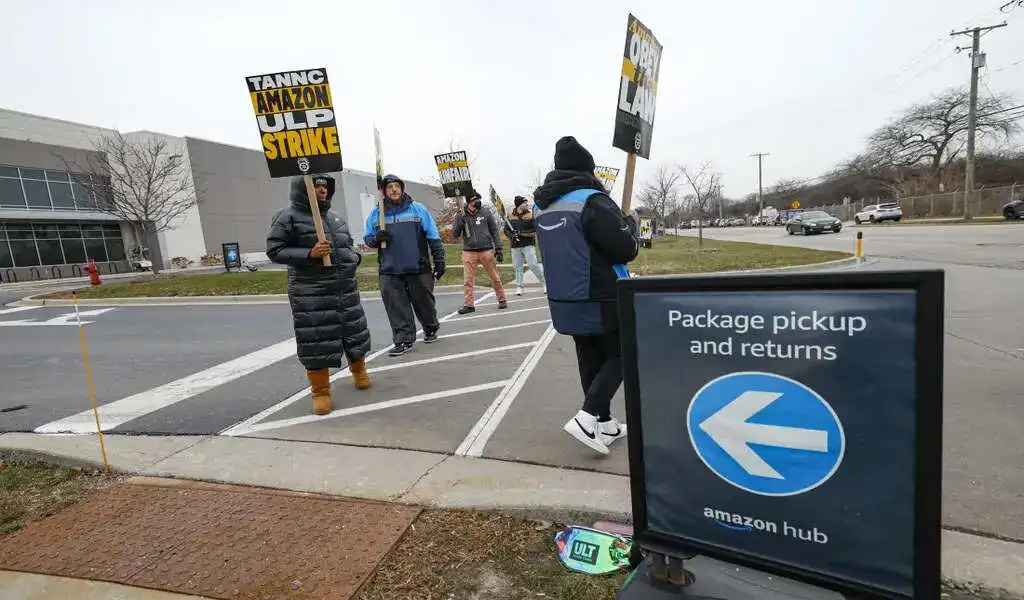Business
Google Falling Short Of Important Climate Target, Cites Electricity Needs Of AI

Three years ago, Google announced an ambitious aim to combat climate change by becoming “net zero,” which means emitting no more climate-changing gases into the atmosphere than it removes by 2030.
However, a study released by the corporation on Tuesday showed that it needs to fulfill that target.
Rather than dropping, emissions increased by 13% in 2023 compared to the previous year. Emissions have increased by 48% from 2019, the baseline year.

Google | PixaBay Image
Google Falling Short Of Important Climate Target, Cites Electricity Needs Of AI
Google attributed last year’s spike to artificial intelligence and the increased demand for data centers, which consume vast amounts of electricity.
Burning coal or natural gas to produce electricity creates greenhouse gas emissions, such as carbon dioxide and methane, which warm the globe and cause more extreme weather.
The corporation has made one of the most significant climate commitments in the sector and is recognized as a leader.
Lisa Sachs, director of the Columbia Center for Sustainable Investment, believes Google could do more to work with cleaner industries and invest in the electricity infrastructure.
“The reality is that we are far behind what we could already be doing now with the technology that we have, with the resources that we have, in terms of advancing the transition,” according to her.
Google Chief Sustainability Officer Kate Brandt told The Associated Press that reaching net zero by 2030 is a tremendously ambitious target.
“We know this is not going to be easy and that our approach will need to continue to evolve,” says Brandt, “and it will require us to navigate a lot of uncertainty, including this uncertainty around the future of AI’s environmental impacts.”
According to some scientists, the fast-rising data centers required to power AI endanger the transition to clean electricity, which is critical for combating climate change. That’s because a new data center can either delay the closing of a fossil-fuel power plant or drive the construction of a new one. Data centers are not only energy-intensive, but they also require high-voltage transmission cables and large volumes of water to stay cool. They’re also noisy.
They are frequently developed where electricity is cheapest, rather than where renewables like wind and solar are a major energy source.
The International Energy Agency estimates that global data center and AI electricity usage will triple by 2026.
The growth of data centers is also putting pressure on the sustainability strategies of other large technology companies. According to an environmental sustainability report released in May, Microsoft’s emissions increased by 29% above the 2020 baseline.
Tech businesses argue that artificial intelligence, including tools like ChatGPT, is not just contributing to climate change but also helping to mitigate it.
In Google’s case, this may mean analyzing data to forecast future flooding or improving traffic flow to conserve gas.
Amanda Smith, senior scientist at the environment NGO Project Drawdown, stated that anyone who uses AI — whether huge corporations or individuals simply creating memes — must do so ethically, which means utilizing energy only when it helps society.

Google | PixaBay Image
Google Falling Short Of Important Climate Target, Cites Electricity Needs Of AI
“It’s up to us as humans to watch what we’re doing with it and to question why we’re doing that,” according to Smith. “When it’s worth it, we can make sure that those demands are going to be met by clean sources of power.”
Google’s emissions increased last year, partly because the corporation used more energy: 25,910 gigawatt-hours more, up from the previous year and more than doubling the hours consumed just four years before. A gigawatt-hour is equivalent to the amount of electricity produced by a power plant servicing hundreds of thousands of households in one hour.
On the plus side, as Google’s usage increased, so did its use of renewable energy.
In 2020, the corporation stated that by 2030, it would meet its vast electricity demand entirely with clean energy. Last year, Google reported an average of 64% carbon-free energy for its data centers and offices worldwide. The corporation’s data centers are 1.8 times more energy efficient than the industry average.
Sachs, at Columbia University, complimented Google for its ambition and honesty, but said she hoped “that Google would join us in a more rigorous conversation about how to accelerate” renewable energy under the climate crisis, “so that it doesn’t get much worse before it starts getting better.”
SOURCE – AP
Business
Sonic the Hedgehog Dominates Christmas Wish Lists

Sonic the Hedgehog is dominating Christmas wish lists this year. The lovable blue hedgehog is back in the spotlight, from sonic the hedgehog toys and games to sonic the hedgehog coloring pages and movie hype.
Sonic-themed holiday merchandise is on fire, from quirky sweaters to action figures flying off shelves. Sonic the Hedgehog Christmas outfits for kids are selling out fast, making them a go-to gift option for festive fun.
Retailers have been quick to recognize Sonic’s holiday appeal. Special promotions and exclusive items, like the Sonic holiday t-shirts, are everywhere.
Everyone’s stocking up on Sonic merchandise, from big-box stores to boutique retailers.
Online shopping platforms are seeing a surge in searches for Sonic items. Whether it’s Sonic Christmas-themed tops or Sonic the Hedgehog coloring pages, Sonic the Hedgehog toys or Sonic and the Hedgehog 3, the demand is skyrocketing.
Retailers who tap into this trend are sure to see strong holiday sales.
Sonic has been around since the early 90s, but his popularity never wanes. With the release of Sonic 3, fans are more excited than ever.
Sonic the Hedgehog 4
Meanwhile, Paramount Pictures is preparing “Sonic the Hedgehog 4,” with the newest addition in the family-friendly genre set for a spring 2027 release.
The announcement comes as “Sonic 3” opens in theatres on Friday, estimated to gross $55 million to $60 million from 3,800 North American locations.
The sequel is shaping up to be a good holiday season blockbuster for Paramount, which explains the desire in future “Sonic” adventures. On the international front, the film will be released on Christmas Day in 52 markets.
On Rotten Tomatoes, critics gave “Sonic 3” an outstanding 87% fresh score.
The first two films grossed a total of $725.2 million at the global box office and generated over $180 million in global consumer expenditure through home entertainment rentals and digital purchases.
They also inspired a spinoff Paramount+ series, “Knuckles,” which premiered earlier this year.
Related News:
Man Creates Candy Cane Car to Spread Christmas Cheer
Business
Amazon Strike Called By Teamsters Union 10,000 Walkout

An Amazon strike has hit facilities in the United States in an effort by the Teamsters union to pressure the corporation for a labour agreement during a peak shopping season.
The Teamsters union told the Associated Press that Amazon delivery drivers at seven facilities in the United States walked off the job on Thursday after the firm failed to discuss a labour contract.
According to the union, Amazon employees in Teamsters union jackets were protesting at “hundreds” of additional Amazon facilities, which the union billed as the “largest strike” in US history involving the company.
The corporation, which employs over 800,000 people in its US delivery network, stated that its services will be unaffected.
It was unclear how many people, including members of Germany’s United Services Union, participated in Thursday’s demonstration. The Teamsters union reported that thousands of Amazon employees were implicated in the United States.
Amazon Strike at 10 Locations
Overall, the group claims to represent “nearly 10,000” Amazon strikers, having signed up thousands of people at roughly ten locations across the country, many of whom have joined in recent months.
The organization has claimed recognition from Amazon going on strike, claiming the firm illegally neglected its obligation to bargain collectively over salary and working conditions.
The Teamsters is a long-standing US union with nearly one million members. It is well-known for securing lucrative contracts for its members at companies like delivery behemoth UPS.
Most of the Teamsters’ Amazon campaigns have concerned drivers working for third-party delivery companies that partner with the tech behemoth.
Amazon denies that it is liable as an employer in those circumstances, which is a point of legal contention. In at least one case, labour officials have taken a preliminary stance in favour of the union.
Stalled Contract Negotiations
Amazon employees at a major warehouse on Staten Island in New York have also chosen to join the Teamsters. Their warehouse is the only Amazon facility in the United States where labour officials have formally recognized a union win.
However, the Amazon strike is because contract negotiations have not progressed since the 2022 vote. It was not one of the areas scheduled to go on strike on Thursday.
Amazon, one of the largest employers in the United States, has long received criticism for its working conditions and has been the target of activists seeking to gain traction among its employees.
Related News:
Amazon Releases Nova, a Fresh Set of Multimodal AI Models.
Business
Amazon Encounters Numerous Strikes As Unions Aim At The Holiday Shopping Surge.

(VOR News) – Thousands of Amazon employees at various sites across the country were scheduled to go on strike on Thursday in an effort by the Teamsters union to pressure the retail behemoth to acknowledge its unionised workers in the United States.
The walkout is expected to concentrate on seven Amazon locations across the country during the holiday purchasing surge and may be the most significant union action against Amazon in the nation’s history.
The business announced on Thursday morning that there had been no effect on operations. It also stated that it is “continuing to concentrate on fulfilling customers’ holiday orders.”
The International Brotherhood of Teamsters maintains that it represents more than 10,000 Amazon employees and contractors in aviation centres, warehouses, and delivery centres.
Amazon has refused to acknowledge the union for many years.
The retail giant, which employs approximately 1.5 million individuals, excludes contractors and part-timers. A strike has been initiated by delivery couriers and warehouse employees at seven distinct locations in order to exert pressure on the company to negotiate a collective bargaining agreement that would encompass modifications to compensation, amenities, and working conditions.
Picketing was intended for New York, Atlanta, Los Angeles, San Francisco, and Skokie, Illinois.
Also, the Teamsters assert that they are establishing picket lines at “hundreds” of additional warehouses and delivery centres by encouraging non-unionized workers to picket under U.S. labour law, which protects workers’ ability to take collective action to further their interests.
“Amazon workers are exercising their power,” Randy Korgan stated to NPR.
“They now realise there is a pathway to take on a corporate giant like this – and that they hold the power.” Amazon responds by accusing the Teamsters of fabricating information regarding the strikes, asserting that the participants are “entirely” outsiders rather than employees or subcontractors of the corporation.
Amazon spokesperson Kelly Nantel stated that “the reality is that they were unable to secure sufficient support from our employees and partners and have invited external parties to harass and intimidate our team.” For more than a year, the Teamsters have been intentionally misleading the public by claiming to represent “thousands of employees and drivers.” They do not.
The Teamsters did not provide a specific duration for the strike; however, they informed NPR that it would extend beyond one day. Workers would receive $1,000 per week in strike money, as per the union.
Teamsters President Sean O’Brien issued a statement in which he stated, “If your package is delayed during the holidays, you can attribute it to Amazon’s insatiable greed.” We established a firm deadline for Amazon to attend the meeting and treat our members equitably. They disregarded it.
The Teamsters granted until December 15 to convene with its unionised employees and develop a collective bargaining agreement.
Amazon has opposed all unionisation efforts in court, asserting that unions were not advantageous to its employees and emphasising the compensation and benefits that the organisation currently provides.
Amazon has been accused of discriminatory labour practices on numerous occasions, including the termination of labour organisers. Furthermore, it has disputed its official status as a contract employer.
Teamsters organize Amazon delivery couriers and other employees.
In June, Amazon established its first unionised warehouse in Staten Island, New York, two years after making history by voting to join the fledgling Amazon Labour Union, which is also affiliated with the Teamsters.
The union is one of the most influential in the United States and Canada, with 1.3 million members. On Thursday, the German United Services Union declared that Amazon employees in Germany would participate in a strike in conjunction with their American counterparts.
In the past, Amazon has experienced demonstrations in Germany and Spain that were related to the holiday season in order to advocate for improved wages and working conditions.
“The holiday season has arrived.” Delivery is anticipated. Patricia Campos-Medina, the executive director of Cornell University’s Worker Institute, asserts that “this is the moment in which workers have control over the supply chain.”
The Teamsters have reported that Amazon’s profits have increased both during and after the pandemic. The corporation is currently valued at over $2.3 trillion, with net income of $15 billion in the most recent quarter alone. It is the second-largest private employer in the United States, following Walmart.
SOURCE: NPR
SEE ALSO:
SoftBank Is Courting Trump With a Proposal To Invest $100 Billion in AI.
TVA News Montreal Becomes Most-Watched News Source in Quebec
-
Politics4 weeks ago
Miller Expects 4.9 Million Foreigners to Leave Canada Voluntarily
-
News3 weeks ago
Nolinor Boeing 737 Crash Lands in Montreal
-
News3 weeks ago
“Shocking Video” Vancouver Police Shoot Armed Suspect 10 Times
-
Tech4 weeks ago
Increasing its Stake in OpenAI by $1.5 Billion is a Possibility for SoftBank.
-
Tech3 weeks ago
Canadian Media Firms Are Suing OpenAI in a Potential Billion-Dollar Dispute.
-
News4 weeks ago
Trudeau Called the Greatest Threat to NATO




























